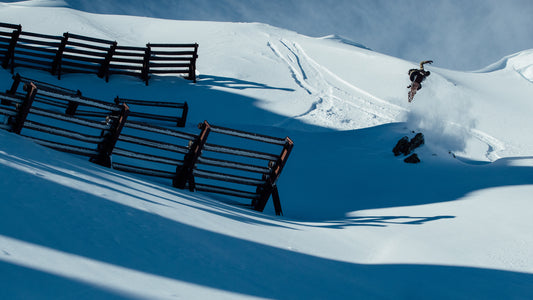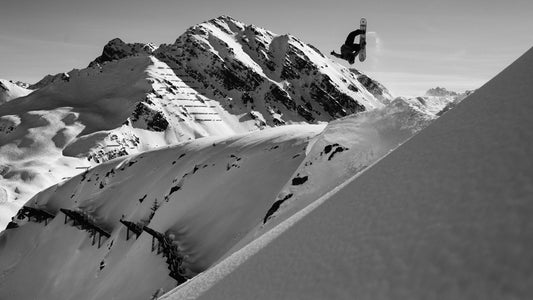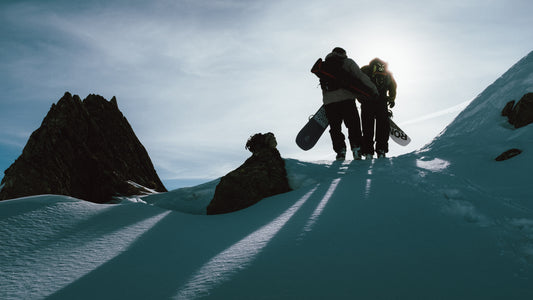
So you’re ready to buy a new professional snowboard but you’re not sure which one to choose? We get it. There are hundreds of different models on the market these days. Some are super versatile; others are pretty specialized – and it can be difficult to figure it all out.
Before you throw a bunch of cash at that new shape you’ve seen with the sick graphic, you should start by asking yourself three questions:
- Am I into freeriding, freestyle or all-mountain riding?
- What flex and profile will suit my riding style?
- What size do I need?
Let’s take a look at all these factors in more detail...
Freeride vs. Freestyle vs. All Mountain
Freeride Snowboards
Freeriding means charging fast, laying down turns and using the natural contours of the mountain – both on the trails and off the groomed trail. If you’re hitting the backcountry you need a board that can handle unpredictable terrain, with a good balance between stability and handling.
A directional shape snowboard is best for this kind of snowboarding. By setting back the stance and making the nose significantly longer than the tail, the rear of your board will naturally sink in deep snow. The extra surface area up front helps the nose to stay on top and mow over any bumps. Some boards take this concept a step further, combining a tapered outline that’s narrower at the tail with a little bit of rocker (upward curve) towards the nose, which makes floating through pow effortless.
All of Rome’s freeride snowboards are directional. The Ravine and the Ravine Select offer a powerful and stable platform during fast, critical descents, while our shorter models (the Stalefish and the Service Dog) are more nimble, which is awesome for threading the needle in those tight tree runs. Of course, there are days when the powder gods don’t oblige. Rest assured, our directional boards can dominate the groomers, too. Find out more about why Rome builds the best freeride snowboards.
Freestyle Snowboards
If learning tricks is your goal, freestyle boards are the perfect tool. These days riders are getting creative all over the mountain (as well as the streets) so shapes, flex patterns and camber profiles can vary a lot within this category. Your choice really depends on your preferred playground and ability level.
Boards designed for hitting big kickers or the pipe need to be stable enough to hold an edge at speed and take a heavy landing without buckling. That means a more responsive and powerful flex, which is best suited to more experienced and powerful riders.
At the other end of the spectrum are more jib-friendly freestyle boards. When it comes to technical boardslides on rails and boxes – or quick butters over rollers in the park – your board should be playful. The key here is a softer flex that’s easy to press, and which you can control at slower speeds. Whichever style of riding you lean towards, Rome’s freestyle snowboards are all based on a twin tip outline – meaning the shape of the nose and tail is the same. Our true twins are the purest example of this philosophy, with a centered stance and identical flex at either end. That means they perform just as well riding switch, which will help you destroy the park – whether you’re sending massive spins over the booters or front-boarding a double kink.
All Mountain Snowboards
Directional twins are also the same shape at either end but have a slightly set back stance, and the tail is often a little stiffer than the nose. These are more versatile; you can still ride switch easily, but they’ll perform better than a true twin in deep snow which makes them great for all mountain freestyle.
For a more in-depth explanation of snowboard shapes click here – or check out our lists of the best park snowboards and the best all mountain snowboards.
Flex and Profile
When you’re choosing a snowboard you need to be honest about your own ability level. If you’re new to the game then a stiff flex is not gonna help you progress; it will be hard to control at slower speeds and the board is more likely to catch an edge. Stiffer flexes really come into their own with advanced riders, since they’re more stable when going at warp speed and can offer more pop if you’re capable of loading the tail properly. If that’s not you, stick to a soft to mid flex.
The decision gets a little more complicated when you look at the profile. Classic camber, reverse camber (aka rocker) and the various hybrid versions and flat profiles all have their pros and cons. You can take a deep dive into these here, but the CliffsNotes version goes like this:
- Classic camber is basically spring loaded. It feels livelier, with more pop, but is less forgiving if you make a mistake
- Rocker makes it easier to float in deep snow and harder to hang an edge on rails, at the expense of pure carving performance
- Flat and Hybrid profiles offer a balance between the two
What size snowboard do I need?
First thing’s first: choosing your snowboard size is not just about length. Sure, length has been the basic metric for decades, but times have changed. Today, width plays an equally important part in the equation – so for instance, you might wanna choose a 158 in a classic all-mountain shape, and a 152 for your fatter powder deck.
To help you figure this out, most manufacturers now include suggested rider weights for each model. This is a good first indicator, but you should keep in mind that smaller, stronger riders can use the same board length as taller, less powerful riders.
In terms of how it’ll feel to ride, the length should also be seen in the context of flex. A softer, longer snowboard can be easier to maneuver than a shorter one that’s super stiff. It can all get a bit confusing, which is why we’ve put together a simple snowboard length chart, together with all the information you’ll need to pick the right snowboard size in one place.
When it comes to width, your choice is obviously influenced by your shoe size – if you’ve got big feet (US11+) then you’ll want to start looking at wide versions, or boards that are designed with extra width as standard. Your preferred binding angles and style of riding come into play here, too. Narrow boards will be quicker from edge to edge (great for carving) but will suffer more from toe and heel drag – especially with flat binding angles. On the flipside, wide boards often need a little more effort to initiate a turn.
The truth is that a few extra millimeters in width can alter a board’s performance more drastically than several centimeters in length. This is especially true for powder riding, where the ultimate goal is float. A long, narrow board can have less lift than something short and wide like the Service Dog that’s been designed specifically for deep snow. So always check the specs sheet, and if you want to know more about the pros and cons of a wider snowboard, you’ll find in-depth information here.
Cool story - but what about the graphics?!
Let’s be honest, it’s hard not to be swayed a little by the graphics on any given board. And that’s fine. Snowboarding has always been about freedom and creativity, and your choice of artwork helps you express your own style. Likewise, the nose of your board might be blunt, pointed, or round. This does have some effect on how it rides (especially if it’s part of a directional shape) but looks are part of it. At the end of the day, you’ve got to choose a board that makes you smile and keeps you stoked to ride.
Want some inspiration? Check out our latest boards here.
How to buy a snowboard?
- Decide whether you’ll be using this board for freeriding, freestyle or all-mountain riding. This will point you towards a directional, twin or directional twin shape
- Assess your ability level and choose an appropriate flex. Softer boards are better for beginners and more playful riding; stiffer boards are more responsive
- The right profile depends on how aggressive you ride and whether you’ll be hitting the backcountry.
- When selecting a size, pay attention to the suggested weight range and keep in mind that width is just as important in how a board rides; short and wide works great in powder
- If you’re psyched on how a board looks it’ll get you more pumped to shred, and that’s cool



